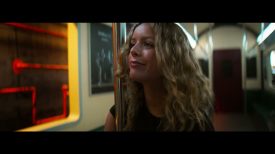By Micha Hilliard
Last November I found myself hurtling along perilous roads, across flat and arid expanses and along azure rivers. I travelled up passes at the end of winding valleys surrounded by snow-capped mountains – all in a shabby old Maruti 800. From time to time, when nearing a solitary road or building construction, the Maruti would come to a screeching halt, and I would hop out of the car with camera in hand. I spent a month in the Himalayan district of Ladakh, North India, documenting an unreported, growing population of Nepalese migrant laborers. As I soon found out, they come to Ladakh because they are unwilling and often unable to bear the economic hardships back home in Nepal. However, once they arrive Ladakh they often end up in a worse condition, slaving away among the rocks and dust: poor, displaced, uneducated, and vulnerable to the harsh high altitude climate.
Before setting out from Delhi across the Himalayas, on the most stunning early morning flight of my life, I decided to break up my shooting schedule into three parts: I would tackle the working conditions first, then the living conditions, and lastly the future prospects. In terms of the equipment, I packed as lightly and unassumingly as possible. Since Ladakh borders both Pakistan and China, it is a heavily militarized zone and Indian authorities are not too keen on having camera-wielding reporters tramping around the place. Furthermore, I was warned that the locals think very poorly of the Nepali migrants. It was clear that I wouldn’t be able to film them openly. Thus, when filling my F-stop Loka bag, I was careful only to include the bare minimum: my Canon 60D, three lenses (Canon EF-S 17-55mm, Canon standard EF 50mm, and Canon EF 70-200mm), a Tascam DR-100 recorder with accompanying Rode NTG-2 microphone, and a Gitzo carbon monopod along with an old tripod. With this set-up, I would easily be mistaken for a tourist.

During the first couple of days, my Nepali friend and interpreter conveyed me in his old Maruti 800 from one construction site to the next, along the gentle Indus valley. (I was most fortunate to have him along, since I don’t speak a word of either Nepali or Hindi. As I learned this summer, while working on a project in the Occupied Palestinian Territories, a good interpreter is worth his or her weight in gold.) Whenever we stopped, he would seek out the civilian foreman and the (more often than not scowling) military overseer to get their permission to film. In the meantime, I would furtively make my way to the laborers, who were busy mixing cement and carrying rocks, and begin to shoot. Normally, it’s an important part of my film-making process to get the consent of all subjects involved and even to show them what I’ve filmed afterward. When dealing with Indian foremen and military personnel, however, I learned quickly that I needed to act decisively or leave with empty hands. With the help of my Gitzo monopod and its smooth twist-locks, I managed to capture six construction sites all together.
I spent the following three weeks in the boys’ dormitory of a Nepali children’s home in Leh. Because of the volatility of their parents’ work, the children of migrant laborers often spend their days on sites, rather than in schools. The children’s home provides them with the opportunity to get proper schooling and, thereby, a way out. By getting to know the children and caretakers, I quickly gained access to a number of Nepali homes and a trove of stories. At this point, I abandoned my run-and-go tactics and adopted a slower and more deliberate approach. I finally had time to study and make the best use of the lighting conditions at hand. Since I packed lightly, I was wholly dependent on the sun to illuminate my subjects. The fact that immense snow-peaked mountains surround Leh on all sides proved to be both a challenge and a blessing. Fortunately, I had enough time to plan ahead, so I shot many scenes – including an action-packed cricket match – just as the sun skimmed the top of the mountains, transformed into a brilliant golden sphere. As a filmmaker, I am now much more aware of the natural light and its properties that vary so widely depending on place, time, and cloud cover.
Another lesson I was forced to learn early on at the children’s home was the value of repetition. Children are difficult to film, since they are always on the move – except when they notice that they are being filmed, at which point they commence to wave and grimace. Before I could get usable shots, I had to accustom the children to the camera. Fortunately, again, I had enough time to shoot the same scenes over and over, such as the caretakers combing the girls’ hair in the morning amidst high-pitched squeals and pained expressions, waiting all the while patiently for the images that I had in mind.
Before I knew it, I found myself on a plane again, Delhi-bound.
As I’ve discovered during this assignment, when documenting the lives of the poor, it is tempting to dwell on the sufferings alone, neglecting all other aspects. For this reason, my finished documentary is filled with beautiful vistas of the Indus valley and the bluest skies imaginable. Even when laborers are seen splitting rocks with hefty sledgehammers or carrying boulders on their heads, it is either in midst of sloping mountain ranges or among autumnal trees bending slightly in the wind. The film is much more hopeful and inspiring than its subject matter would seem to warrant. As a documentarian, however, I see it as my responsibility to lift my subjects up, rather than lowering them down even further; to show them compassion, bestow onto them dignity, and put their present sufferings in the light of future hope.
Home from Micha Hilliard on Vimeo.
Micha Hilliard is a freelance filmmaker based in Zurich, Switzerland. Visit his personal website here or follow his blog here.






